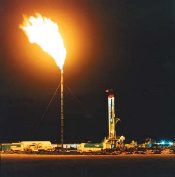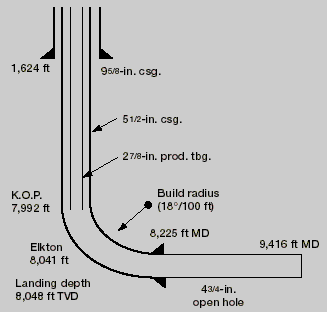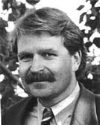Exploitation of new underbalanced drilling technologies
DRILLING / COMPLETION TECHNOLOGYExploitation of new underbalanced drilling technologiesTwo reservoirs in Central and NW Alberta were drilled and completed with horizontal boreholes and underbalanced techniques with significant productivity improvements over previous completionsBrian McGregor, Apache Canada Ltd., Calgary
Initial production results from the two wells drilled underbalanced indicated significant improvement, compared to production from offsetting vertical and horizontal wells drilled overbalanced. The enhanced production and improved recovery has resulted in favorable economics for the application of this technology
Why UBD and CT? Maintaining underbalanced conditions during drilling sustains gas inflow and prevents the effects of invasive formation damage. This can result in better well productivity and eliminate the need for sophisticated drilling fluid systems and remedial stimulation. UBD will also increase drilling penetration rate (ROP) and improve bit life, and it can prevent lost circulation and differential sticking. UBD is particularly advantageous when applied to horizontal wells, not only for the above noted advantages, but also for the advantage of real-time production evaluation. Production testing during the drilling of the horizontal section can aid as a steering tool, and the reservoir can also be evaluated. To fully exploit and ensure the benefits of underbalanced drilling, Apache has found coiled tubing drilling to be the preferred method. Coiled tubing drilling is an emerging technology that has particular advantages when applied to underbalanced operations. When dealing with a live well situation, safety is a major concern. With a continuous drillstring, the need for making connections is eliminated and the drilling crew is only exposed during BHA deployment. Another advantage arising from the absence of pipe connections is in maintaining a continuous circulating pressure and avoiding the pressure fluctuations associated with jointed pipe. An internal wireline within the coil allows for real-time directional, annular pressure and gamma ray measurements. The real-time measurements allow for better control, ensuring that the well path stays within the reservoir and that underbalanced conditions are continuously maintained. These measurements can be correlated to well productivity. CT drilling has its drawbacks, especially on the limitations of horizontal length achievable due to buckling and tubing lockup, as well as hole diameter and motor capacity. It is believed, however, that the advantages far outweigh the limitations. Case History No. 1 Well 12-16-33-3W5M was drilled in May 1997, targeting the Elkton formation, a dolomitized, shallow-water carbonate comprising dense limestones and porous dolomites. The reservoir can be up to 20 ft thick, with porosities reaching 20%; and it contains gas with an H2S content up to 0.5%.
The reservoir was placed on production in 1967, at an initial pressure of 3,400 psi, with several operators participating in the pool development. Initially, exploitation was by vertical wells drilled overbalanced and subsequently hydraulically fractured. Since 1990, area operators have applied 3-D seismic, followed by horizontal drilling, as techniques to further exploit the remaining reserves. Reservoir pressure currently is 2,400 psi. Changing to UBD. Prior to Apache’s first horizontal well, such wells were drilled overbalanced. But overbalanced, horizontal-well applications indicated moderate, if any, improvement over vertical wells. And subsequent stimulation attempts of damaged horizontal wells have proven to be ineffective. It was Apache’s opinion that the Elkton pool was a good candidate for application of horizontal UBD. The slow production rate decline was an indication that the gas reservoir was being underexploited and, if successful, this technology would be proven for follow-up applications. Although the drilling spacing unit (DSU) was under production from an existing vertical well, it was believed that a horizontal well drilled underbalanced would be an economic acceleration project, and the enhanced production would more effectively drain the reservoir. Drilling procedure, equipment. A conventional rig was used to drill vertical and build sections; 5-1/2-in. casing was landed 7 ft below the Elkton top at an inclination of 90°. Intermediate casing was set at 8,048 ft TVD (8,225 ft MD). The accompanying figure shows the well design schematic for the 12-16 well. The build section was drilled with a medium profile at an aggressive build rate of 18°/100 ft to minimize potential for cuttings-bed development. The 5-1/2-in. casing was selected to minimize nitrogen requirements for obtaining underbalanced conditions, yet still maintain adequate annular velocities for hole cleaning. The horizontal section was drilled with a coiled tubing, hybrid-mast unit and substructure complete with V-door, catwalk and pipe racks. The unit was equipped with 2-7/8-in. CT and injector with a hydraulic power unit and control cabin. Pumping equipment included a fluid pumper, N2 pumper and a N2 bulk storage unit. The bottomhole assembly (BHA) included positive-displacement mudmotor (4:5 lobes), orienting tool, pressure sub and gamma ray tool. The CT was fitted internally with wireline for gamma ray and pressure-sub operations; it was also equipped with two 1D4-in. steel capillary tubes for hydraulic operation of the orienting tool. Surface handling equipment included a BOP stack complete with packoff assembly. Snubbing operations were facilitated through use of wireline and a 30-ft lubricator. A 500-bbl test separator with choke manifold, sample catchers and flarestack was used, as well as two 400-bbl upright tanks for diesel storage and one 400-bbl tank for kill fluid (water). Diesel was used as the drilling fluid and was combined with nitrogen to achieve the underbalanced conditions. N2 injection was reduced as gas inflow from the wellbore increased. The operation was closed-loop and with no pits (sumpless) to minimize environmental impact. Increased gas production. The horizontal section was drilled in two bit runs starting at 8,225 ft, with wiper trips conducted at 150-ft intervals. The BHA was tripped out at 8,694 ft to change motors and the bit. Gas flow steadily increased over the interval to 5–6 MMscfd. The second bit run drilled from 8,694 to 9,416 ft. At that depth, drilling was terminated because all of the tubing on the reel had been used. Underbalanced conditions were continuously maintained, with about 1,160 psi pressure drawdown, and gas production continued to increase over the entire interval. A flowrate at the end of UBD indicated a rate of 22 MMscfd. A total of 1,191 ft of horizontal section was drilled. Based on the high gas rate obtained, it was determined that another lateral hole would not be necessary. The 12-16 well was placed on production in June 1997. The well had an initial production rate of about 9 MMscfd at an estimated drawdown of 580 psi. This rate was reduced to 6.5 MMscfd due to gas facility restrictions. The well had cumulative production of 2 Bcf after one year’s production. Case History No. 2 Well 104/1-16-82-7W6M was drilled in April 1998 and targeted the Paddy formation in NW Alberta, a high-grade beach sand with high permeability in the range of 500 mD and about 27% porosity. The gas reservoir is 28 ft thick, with a 40-ft active underlying aquifer; reservoir pressure is 375 psi. Offsetting vertical-well production is in the range of 700–800 Mscfd. Stimulation of the vertical wells has not been practical due to the water influx encountered from fracturing into the aquifer. The objective of this well was to place an undamaged horizontal section high in the reservoir to maximize production and minimize water coning. The drilling program was similar to Well 12-16 in that 5-1/2-in. intermediate casing was set at 90° in the Paddy with a conventional rig. Intermediate casing was landed at 2,130 ft MD (1,821 ft TVD). The drilling rig was then moved off and the CT hybrid unit was moved on. The first BHA drilled out the cement, and N2 was added to the diesel to create the underbalanced conditions. The horizontal section was then drilled from 2,130 to 2,660 ft MD, with wiper trips conducted at 150-ft intervals. It was determined that well productivity was too low because the first leg had been placed too high in the zone. It was decided to sidetrack lower into the formation to access more productive reservoir. The second leg was drilled from 2,190 to 2,460 ft MD. The well was placed on test after more productive formation had been penetrated, and a stabilized flowrate of 5.0 MMscfd with 275-psi backpressure was established. A total of 800 ft of combined horizontal section was drilled in two legs. The 104/1-16 well was placed on production in April 1998, with an initial production rate of about 3.7 MMscfd at an estimated 20% drawdown. The well had cumulative production of 0.8 Bcf in the first 8 months of production. Conclusions The enhanced production and improved recovery resulted in economic successes in two widely different reservoirs with different characteristics. The design of the two wells allowed for proper application of UBD technology. Without the real-time production data, it is likely that both of these projects would have been terminated earlier, and the 12-16 well would not have encountered as much productive reservoir. Well 104/1-16, likely, would not have not been sidetracked and may have resulted in a dry hole. In the case of Well 12-16, suspending an existing vertical producer in the DSU and redrilling with an underbalanced horizontal proved to be an economic project and will accelerate production with the possibility of draining offsetting acreage. Additional DSUs with existing vertical producers can now be evaluated for this method of exploitation with more favorable economics. The 104/1-16 well also proved to be effective in that a highly productive wellbore was placed above the active aquifer. The relative ease in which sidetracks were made on the second well also suggests that future applications can incorporate multilaterals in the planning process. It also suggests that existing horizontal wells that were drilled overbalanced can be reentered and an underbalanced lateral drilled to improve productivity. Based on performance of the Apache wells drilled underbalanced, other operators are
applying UBD technology on future horizontal wells. Apache is also in the process of
re-evaluating several of its producing reservoirs for the application of this technology.
The author
Copyright © 1999 World
Oil |
- Applying ultra-deep LWD resistivity technology successfully in a SAGD operation (May 2019)
- Adoption of wireless intelligent completions advances (May 2019)
- Majors double down as takeaway crunch eases (April 2019)
- What’s new in well logging and formation evaluation (April 2019)
- Qualification of a 20,000-psi subsea BOP: A collaborative approach (February 2019)
- ConocoPhillips’ Greg Leveille sees rapid trajectory of technical advancement continuing (February 2019)



 Brian
McGregor, Drilling Manager, Apache Canada Ltd.,
Calgary, earned a BS in mechanical engineering from the University of Calgary. Before
joining Apache, he held a variety of drilling positions with Chevron, Westcoast Petroleum
and Dekalb Energy. He is a member of APEGGA, CADE and SPE. Previous underbalanced drilling
presentations have been made to: SPE/ICOTA, CIM, CADE, CERI and an International Forum in
The Hague.
Brian
McGregor, Drilling Manager, Apache Canada Ltd.,
Calgary, earned a BS in mechanical engineering from the University of Calgary. Before
joining Apache, he held a variety of drilling positions with Chevron, Westcoast Petroleum
and Dekalb Energy. He is a member of APEGGA, CADE and SPE. Previous underbalanced drilling
presentations have been made to: SPE/ICOTA, CIM, CADE, CERI and an International Forum in
The Hague.
